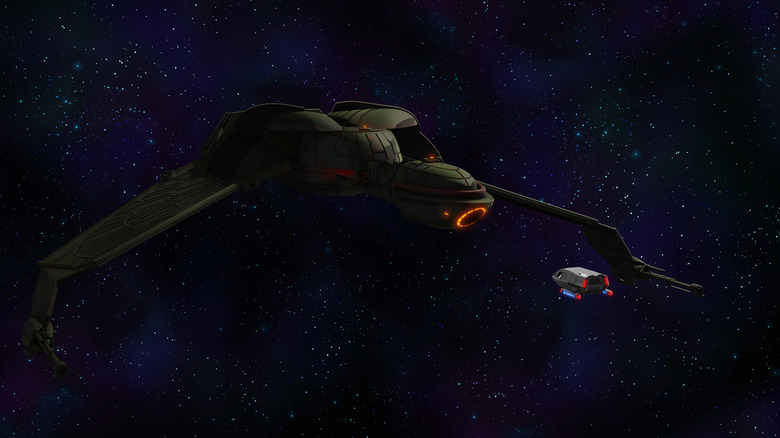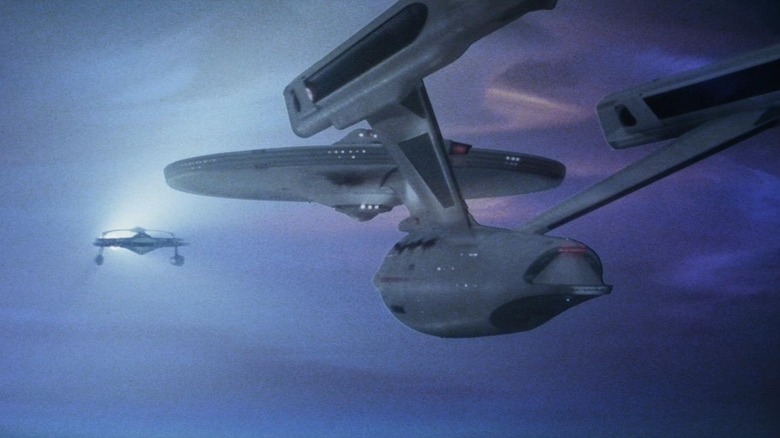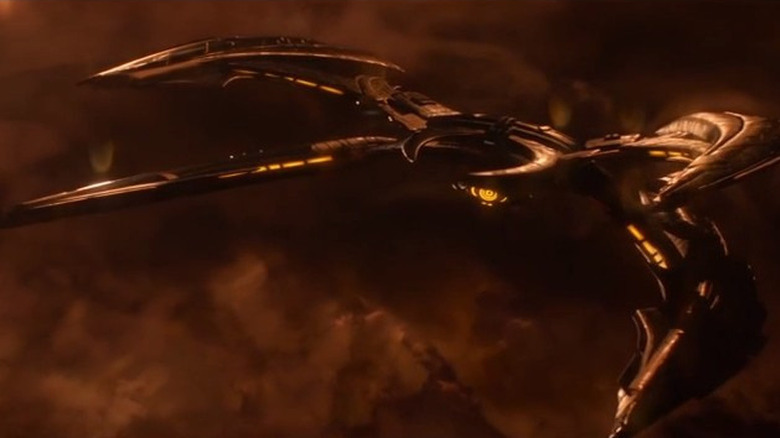Star Trek: Lower Decks Reaches Into Star Trek II: The Wrath Of Khan For Its Season Finale
Warning: this post contains spoilers for the latest episode of "Star Trek: Lower Decks."
"Star Trek" just can't seem to get away from "Star Trek II: The Wrath of Khan."
Sometime in the mid-1990s, after the release of "Star Trek VI: The Undiscovered Country," a consensus began to form around the Trek movies to date, and it became generally agreed upon that "Wrath of Khan" was the best of the six. Opinions on this matter are varied, of course — I personally prefer both "Star Trek VI" and "Star Trek: The Motion Picture" — but very generally speaking, "Khan" regularly tops unofficial lists of the best of the movies. Once the popular opinion had been established, the makers of "Star Trek" began to take notice, and began paying the film very aggressive homage.
Reminder: the finale of "Wrath of Khan" takes place in a nebula wherein the U.S.S. Enterprise, commanded by Admiral Kirk (William Shatner), and the hijacked U.S.S. Reliant, run by Khan (Ricardo Montalbán) have lost their abilities to detect each other or fire weapons with accuracy. Each weapons volley is carefully planned, and each strike does major damage. The battle ends when Kirk gets the drop on Khan, and Khan, dying, activates a terraforming bomb called the Genesis Device.
The circumstances of that finale have been repeated at least three additional times throughout "Star Trek," with the most recent coming in the new "Star Trek: Lower Decks" episode "Old Friends, New Planets." "Lower Decks" doesn't just set its climactic battle in a nebula, with two slow-moving enemy ships unable to detect each other or fire accurately, but Beckett Mariner (Tawny Newsome) is even armed with a Genesis Device. Everything old is new again.
The stubborn legacy of 'Star Trek II'
"Star Trek," when it's operating at the height of its powers, is careful to present a great deal of philosophical ambiguity in its stories. In "Star Trek," there are rarely instances of outright heroes or villains. Instead, characters are stronger when they merely have a deadlocked devotion to a notable, seemingly noble goal. Also, "Star Trek" ostensibly takes place in a post-war universe, meaning even the ignoble characters rarely long for petty goals such as violence, destruction, or revenge.
After "Star Trek II," however, villainy became more common and revenge became a regular practice. Stuart Baird's 2002 film "Star Trek: Nemesis" featured a vengeance-minded villain armed with a warship that got into a scrape with the Enterprise in a nebula. The 2009 "Star Trek" film likewise had a vengeance-minded supervillain at its core. "Star Trek Into Darkness" brought back an alternate universe version of Khan, and a crazed vengeance-minded villain (who captained a ship called the U.S.S. Vengeance). "Star Trek Beyond" was about an abandoned villain who sought vengeful destruction on the Federation. Four films in a row copied "Khan."
Additionally, the third season of "Star Trek: Picard" featured a cackling villain who faced off against a Federation ship in a nebula. And now, with "Old Friends, New Planets," exact shots from "Star Trek II" are deliberately repeated. When Mariner's Genesis Device is switched on, the effects resemble those from the 1982 film.
With "Lower Decks," however, the effect is more whimsical ... and grounded. While Mariner's enemy is not so much a revenge-crazed villain but a flawed man who needed to reassess his motivations. Imagine "Wrath of Khan" if Khan merely had a wounded ego.
In brief, he can be talked out of his plan.
The mutable villain
And therein lies the crucial difference between an outright villain, and traditional "Star Trek" antagonists. A villain is philosophically immovable. Even with strenuous debate, a villain will not abandon their bloody-minded plan to commit acts of violence. Michael Myers cannot be presented with morals or logic as a means of preventing him from killing people. He is a machine that kills. Likewise with Khan from "Star Trek II." He is wounded and dying and uses his dying breaths to insult his enemy. There isn't even the smallest moment of regret or contrition. Likewise with Shinzon (Tom Hardy), Nero (Eric Bana), Khan II (Benedict Cumberbatch), Kroll (Idris Elba), and Vadic (Amanda Plummer). There is no sense that these characters are using violent means to enact a righteous principle. They merely long for destruction.
The "villain" in "Old Friends," meanwhile, explains his goals plainly, but the episode also hearkens back to the early moments of his dark path. When Mariner confronts him in a nebula, "Wrath of Khan"-style, it's not a test of military tactics or battlefield maneuverability. It's a conflict of characters. Mariner and her foe knew each other in the past, and Mariner is wise enough to open his old wounds, to make him discuss the death he previously caused and the precise moment of his radicalization.
Wisely, "Lower Decks" lets the character have his moment of regret, his moment of attempted contrition. It's a moment that makes him human, that makes him relatable.
"Lower Decks" hauls out the "Wrath of Khan" setup, but cleverly subverts it, allowing a tired Trek trope to serve as a willy background joke while legitimate character work is happening in the foreground. Perhaps Trek finally has "Khan" out of its system now.


